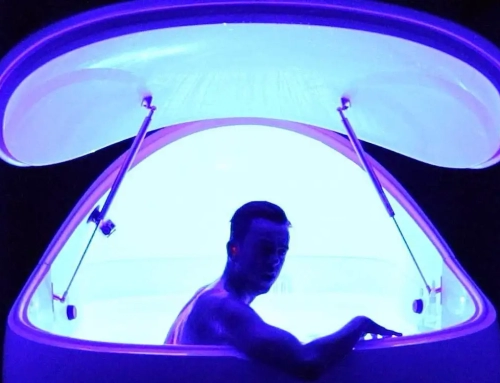Want to float your way to less stress, anxiety, depression, and pain? Though it sounds too good to be true, science says it’s possible.
While floating in a sensory-deprivation tank may sound interesting, unusual & a bit concerning, it’s meant to have the opposite effect. Magnesium-saturated water (aka epsom salt), kept at a temperature that matches your skin’s, keeps you effortlessly buoyant so you don’t have to worry about staying afloat. With little to touch, taste, smell, hear, or feel, you’re wrapped in a cocoon of warmth and silence, with only your thoughts keep you company. Herein lies the magic of floating – it puts you in a meditative state to better heal what ails you.
Origins of floating
Floating in salt water for therapeutic reasons is not new. People have made pilgrimages to the Dead Sea for centuries. However, over the past 15 years, there’s been a renewed interest in the practice, with chic flotation studios, offering 60-90-minute float sessions, cropping up all over metropolitan areas.[1]
In the late ’50s, neuroscientist and psychoanalyst John C. Lilly, MD studied the effects of sensory deprivation flotation on anxiety disorders, addiction, and post-traumatic stress disorder. Due to the impressive benefits he saw for people with these conditions, he decided to team up with two business partners — Glenn and Lee Perry — to develop a commercial float tank that anyone could use.
In the ‘70s, concerns over water cleanliness halted the industry’s growth. Nonetheless, the scientific study of floating — namely the effects of isolation on the brain — continued within the academic community.
Floating goes mainstream
About 15 years ago, a UK-based company called ISOPOD enlisted a team of engineers to resolve concerns over water cleanliness. With the latest water-filtration technology, they built a system to remove particles 15 times smaller than a commercial filtration unit. As a result, small studios popped up in England, Vancouver, Toronto, Portland, and Seattle; then in larger hubs like NYC, San Francisco, and Los Angeles. Now, you can float in nearly any major metropolitan area at a studio like the one featured in this video above, Pause Float Studio in Venice, California.
So why would you do it? Read on for the science-backed benefits of floating.
5 major health benefits of floating
Floating decreases anxiety and depression and improves sleep
Under stress, your hypothalamus (the almond-sized part of your brain just above your brainstem) signals your adrenal glands to release the stress hormones adrenaline and cortisol. Chronic stress leads to an overactive hypothalamus, which can lead to depression.[2] Floating helps combat depression and anxiety by minimizing your cortisol production.[3]
In one study[4], people who floated for 12 sessions noticed decreased pain, stress, anxiety, and depression as well as improved sleep quality and general optimism. The results lasted up to four months post-flotation.
In a single-subject study[5], a 24-year-old diagnosed with autism, PTSD, anxiety, and depression participated in regular float sessions for one and a half years. She experienced beneficial therapeutic effects including improved quality of life, subjective sense of wellbeing, and healthier behaviors. The study quotes her stating: “I feel good, well, like a new person, and so it has made a great difference… It really has and I really want to continue with this because I really need it.”
Floating lowers stress
Floating combats stress in two main ways. First, the water’s magnesium inhibits ACTH, a hormone that drives your adrenal glands to release the stress hormone cortisol.[6] Magnesium also improves sleep quality, which contributes to feeling less stressed.[7]
The sensory deprivation component of floating also minimizes stress. In a recent study, people who floated eight times in two weeks saw their cortisol decrease by 21.6 percent. They also showed a 50.5 percent decrease in cortisol variability, meaning, they handled stressful situations better without the cortisol spikes.[8]
A meta-analysis of 27 studies revealed that floating also has relaxation, mood, and performance-enhancing effects, particularly in cases of burnout or chronic fatigue.[9]
Floating relieves physical pain
For people with chronic, stress-related muscle pain and burnout-related depression, floating served as an integral part of pain treatment plans, in one study.[10] Since floating oxygenates your body by promoting vasodilation — better blood flow to the brain, organs, and limbs — it serves to minimize muscular pain and even pain from degenerative disc disease or herniated disks.
Specifically floating provides significant reductions in pain, muscle tension, stress, anxiety, and sadness for those who suffer from fibromyalgia. Floating also increases feelings of relaxation, well-being, energy, and ease of movement in the same group of people.[11]
Floating enhances athletic performance
Floating helps you bounce back faster from workouts by reducing lactic acid in the blood. By floating fee of gravity, lactic acid passes out of the muscles faster, which reduces overall muscle stiffness and pain.[12] Floating benefits extend to athletes on the field as well. One study on basketball players found strong evidence of athletic skill improvement post floating. These results may be due to a lower arousal state post floating, which enabled the players to maintain better focus while shooting foul shots.[13]
Floating benefits creativity
Musicians, writers, and creative performers also gain from floating. A study in the journal Music and Medicine found that floating improved the technical ability of musicians during jazz improvisation.[14]
What to expect with your first float
A typical float session lasts 60 to 90 minutes. You may experience restlessness in the tank on your first float, until your body and mind settle into the sensory deprivation. Some float studios have water-based speakers with guided meditations to help you ease into your session.
Original article courtesy of Dave Sprey
For more information on the Benefits of Floatation Therapy please click HERE.





